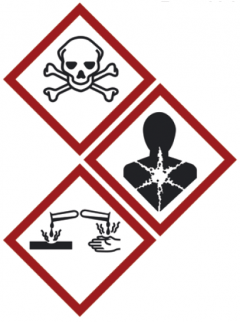Classification according to GHS
The Globally Harmonised System (GHS) is the UN's global system for the classification and labelling of dangerous substances. GHS ensures that a dangerous substance is classified in the same hazard category all over the world. This means that the hazard pictogram of a dangerous substance is the same all over the world.
An example of a product label with a hazard pictogram is shown below.
You can use a comparison poster with the old symbols and download the new pictograms.
Dangerous substances are divided into twenty-nine hazard classes. The hazard classes are further subdivided into subclasses and into hazard categories 1, 2, 3 or 4, of which category 1 is the most dangerous. These categories also have a signal word (danger or warning).
In 2009, the global GHS system was introduced in Europe in a slightly modified form. The EU GHS, the European legislation on the classification, labelling and packaging of chemical substances and mixtures. This regulation, also called the CLP regulation (Regulation on Classification, Labelling and Packaging) is replacing the old substances and preparations directive in time.
At the moment there is a transitional period in which, in addition to the new pictograms, there are also old orange symbols. The new pictograms are in a red diamond.
An example of a product label with hazard pictograms is shown below.
Page content
Hazard
Toxic if swallowed. Toxic in contact with skin. Causes severe burns. May cause an allergic skin reaction. Toxic if inhaled. Do not use until you have read and understood the safety instructions. Do not inhale dust/smoke/gas/mist/vapour/spray mist. Use only outdoors or in a well-ventilated area. Use the necessary personal protective equipment.
Dokterhoe chemie B.V.
Chemieweg 123
1234AB
Dokterhoeven
012-3456789
Information on the label
The label contains at least the following information:
- the name, address and telephone number of the supplier;
- the nominal quantity of the substance or mixture, unless the quantity is specified elsewhere on the package;
- the product specification: the name of the substance and a so-called identification number.
Where applicable:
- the hazard pictograms (black pictograms placed in a red bordered white diamond);
- H phrases (Hazard, hazard statement);
- P phrases (Precautionary, safety recommendation);
- the signal word 'Danger' or 'Warning';
- additional information.

